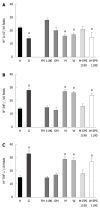Therapeutic effect of Streptococcus thermophilus CRL 1190-fermented milk on chronic gastritis
- PMID: 20355240
- PMCID: PMC2848370
- DOI: 10.3748/wjg.v16.i13.1622
Therapeutic effect of Streptococcus thermophilus CRL 1190-fermented milk on chronic gastritis
Abstract
Aim: To investigate the potential therapeutic effect of exopolysaccharide (EPS)-producing Streptococcus thermophilus (S. thermophilus) CRL 1190 fermented milk on chronic gastritis in Balb/c mice.
Methods: Balb/c mice were fed with the fermented milk for 7 d after inducing gastritis with acetyl-salicylic acid (ASA, 400 mg/kg body weight per day for 10 d). Omeprazole was included in this study as a positive therapeutic control. The gastric inflammatory activity was evaluated from gastric histology and inflammation score, number of interleukin-10 (IL-10), interferon-gamma (INFgamma) and tumor necrosis factor-alpha (TNF-alpha) cytokine-producing cells in the gastric mucosa, and thickness of the mucus layer.
Results: Animals receiving treatment with the EPS-producing S. thermophilus CRL 1190 fermented milk showed a conserved gastric mucosa structure similar to that of healthy animals. Inflammation scores of the fermented milk-treated mice were lower than those of mice in the gastritis group (0.2 + or - 0.03 vs 2.0 + or - 0.6, P < 0.05). A marked decrease in INFgamma(+) (15 + or - 1.0 vs 28 + or - 1.2, P < 0.05) and TNF-alpha(+) (16 + or - 3.0 vs 33 + or - 3.0, P < 0.05) cells and an increase in IL-10(+) (28 + or - 1.5 vs 14 + or - 1.3, P < 0.05) cells compared to the gastritis group, was observed. Also, an increase in the thickness of the mucus gel layer (2.2 + or - 0.6 vs 1.0 + or - 0.3; 5.1 + or - 0.8 vs 1.5 + or - 0.4 in the corpus and antrum mucosa, respectively, P < 0.05) compared with the gastritis group was noted. A milk suspension of the purified EPS from S. thermophilus CRL1190 was also effective as therapy for gastritis.
Conclusion: This study suggests that fermented milk with S. thermophilus CRL 1190 and/or its EPS could be used in novel functional foods as an alternative natural therapy for chronic gastritis induced by ASA.
Figures




Similar articles
-
Prevention of chronic gastritis by fermented milks made with exopolysaccharide-producing Streptococcus thermophilus strains.J Dairy Sci. 2009 Jun;92(6):2423-34. doi: 10.3168/jds.2008-1724. J Dairy Sci. 2009. PMID: 19447974
-
Extracellular Polysaccharide Extraction from Streptococcus thermophilus in Fermented Milk.Microbiol Spectr. 2022 Apr 27;10(2):e0228021. doi: 10.1128/spectrum.02280-21. Epub 2022 Mar 28. Microbiol Spectr. 2022. PMID: 35343770 Free PMC article.
-
Exopolysaccharide-producing Streptococcus thermophilus CRL1190 reduces the inflammatory response caused by Helicobacter pylori.Benef Microbes. 2017 May 30;8(3):451-461. doi: 10.3920/BM2016.0186. Epub 2017 May 15. Benef Microbes. 2017. PMID: 28504579
-
New advances in exopolysaccharides production of Streptococcus thermophilus.Arch Microbiol. 2017 Aug;199(6):799-809. doi: 10.1007/s00203-017-1366-1. Epub 2017 Mar 29. Arch Microbiol. 2017. PMID: 28357474 Review.
-
Streptococcus thermophilus, an emerging and promising tool for heterologous expression: Advantages and future trends.Food Microbiol. 2016 Feb;53(Pt A):2-9. doi: 10.1016/j.fm.2015.05.003. Epub 2015 May 19. Food Microbiol. 2016. PMID: 26611164 Review.
Cited by
-
Phenotypic and transcriptional analysis of the antimicrobial effect of lactic acid bacteria on carbapenem-resistant Acinetobacter baumannii: Lacticaseibacillus rhamnosus CRL 2244 an alternative strategy to overcome resistance?".Res Sq [Preprint]. 2023 Jul 21:rs.3.rs-3151881. doi: 10.21203/rs.3.rs-3151881/v1. Res Sq. 2023. Update in: Sci Rep. 2023 Aug 31;13(1):14323. doi: 10.1038/s41598-023-41334-8. PMID: 37503046 Free PMC article. Updated. Preprint.
-
The genomic basis of the Streptococcus thermophilus health-promoting properties.BMC Genomics. 2022 Mar 16;23(1):210. doi: 10.1186/s12864-022-08459-y. BMC Genomics. 2022. PMID: 35291951 Free PMC article.
-
Probiotics as a Therapeutic Approach for Non-infectious Gastric Ulcer Management: a Comprehensive Review.Probiotics Antimicrob Proteins. 2025 Feb;17(1):393-418. doi: 10.1007/s12602-024-10348-7. Epub 2024 Aug 27. Probiotics Antimicrob Proteins. 2025. PMID: 39190267 Review.
-
New Insights into Various Production Characteristics of Streptococcus thermophilus Strains.Int J Mol Sci. 2016 Oct 12;17(10):1701. doi: 10.3390/ijms17101701. Int J Mol Sci. 2016. PMID: 27754312 Free PMC article. Review.
-
Identification and characterisation of an iron-responsive candidate probiotic.PLoS One. 2011;6(10):e26507. doi: 10.1371/journal.pone.0026507. Epub 2011 Oct 19. PLoS One. 2011. PMID: 22039501 Free PMC article.
References
-
- Bienia A, Sodolski W, Luchowska E. The effect of chronic alcohol abuse on gastric and duodenal mucosa. Ann Univ Mariae Curie Sklodowska Med. 2002;57:570–582. - PubMed
-
- Gamboa-Dominguez A, Ubbelohde T, Saqui-Salces M, Romano-Mazzoti L, Cervantes M, Domínguez-Fonseca C, de la Luz Estreber M, Ruíz-Palacios GM. Salt and stress synergize H. pylori-induced gastric lesions, cell proliferation, and p21 expression in Mongolian gerbils. Dig Dis Sci. 2007;52:1517–1526. - PubMed
-
- Beck PL, Xavier R, Lu N, Nanda NN, Dinauer M, Podolsky DK, Seed B. Mechanisms of NSAID-induced gastrointestinal injury defined using mutant mice. Gastroenterology. 2000;119:699–705. - PubMed
-
- Goel RK, Bhattacharya SK. Gastroduodenal mucosal defence and mucosal protective agents. Indian J Exp Biol. 1991;29:701–714. - PubMed
-
- Moskowitz RW. The appropriate use of NSAIDs in arthritic conditions. Am J Orthop (Belle Mead NJ) 1996;25:4–6. - PubMed
Publication types
MeSH terms
Substances
LinkOut - more resources
Full Text Sources
Other Literature Sources

